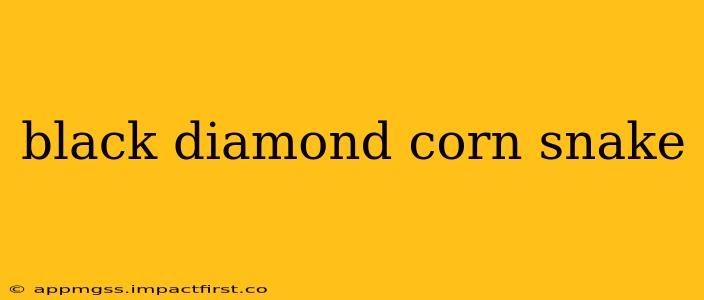The black diamond corn snake, a captivating variant of the common corn snake (Pantherophis guttatus), is prized by reptile enthusiasts for its striking, dark coloration. This guide delves into the characteristics, care requirements, and fascinating aspects of this beautiful snake.
What is a Black Diamond Corn Snake?
The "black diamond" isn't a formally recognized morph like some other corn snake variations (e.g., Amel, Snow). Instead, it's a descriptive term for corn snakes exhibiting a predominantly dark, almost black, body color with distinctive diamond-shaped markings. These markings can vary in shade, from dark brown or charcoal to a deep, inky black, and are often outlined with slightly lighter edges, creating a striking contrast. The intensity of the black and the clarity of the diamond pattern can differ considerably between individual snakes.
What Makes Black Diamond Corn Snakes Unique?
Their striking coloration is the most obvious unique feature. The intense dark pigmentation sets them apart from other corn snake morphs, making them visually impressive. The variations in the darkness and the definition of the diamonds contribute to the individuality of each snake. While not genetically distinct from other corn snakes, their appearance is certainly memorable.
How Do I Care for a Black Diamond Corn Snake?
Caring for a black diamond corn snake is no different from caring for any other corn snake. They have similar needs regarding:
Enclosure:
A suitably sized enclosure is crucial. Juveniles can thrive in a 10-gallon tank, but adults will need a much larger enclosure, such as a 20-long or even a 40-gallon breeder tank, depending on the snake's size and your preferences. Provide proper ventilation to prevent excess humidity.
Substrate:
Aspen shavings, cypress mulch, or paper towels are suitable substrates. Avoid cedar or pine shavings, as they can be harmful to snakes.
Temperature and Humidity:
Maintain a temperature gradient within the enclosure, using a heat lamp or under-tank heater. A warm side (around 88-92°F) and a cooler side (around 75-80°F) are essential. Humidity should be moderate, around 40-60%, and can be achieved through a water bowl and occasional misting.
Feeding:
Feed young corn snakes appropriately sized frozen/thawed mice every 5-7 days. As they grow, adjust the size and frequency of feedings accordingly. Adult corn snakes typically feed once a week or less frequently.
Handling:
Handle your corn snake gently and regularly to help it socialize and become comfortable around humans. Always wash your hands before and after handling to maintain hygiene and prevent the transmission of bacteria or diseases.
Are Black Diamond Corn Snakes Aggressive?
No, corn snakes, including black diamond corn snakes, are generally docile and non-aggressive. They are popular pets because of their calm temperament and relatively easy care. However, like any animal, they can bite if they feel threatened or scared. Gentle handling and proper husbandry will help keep your snake calm and reduce the chances of biting.
How Much Does a Black Diamond Corn Snake Cost?
The cost varies depending on the breeder, the age of the snake, and the specific characteristics of the individual animal. Expect to pay a premium for a particularly well-marked or striking specimen. It’s always best to purchase from a reputable breeder who can provide information about the snake's lineage and health.
How Long Do Black Diamond Corn Snakes Live?
With proper care, black diamond corn snakes can live for 15-20 years or even longer.
Where Can I Find a Black Diamond Corn Snake?
Reputable reptile breeders and pet stores specializing in snakes are the best places to source a healthy black diamond corn snake. Thoroughly research potential sellers to ensure you are getting a healthy animal from an ethical source. Always check the snake for any signs of illness or injury before purchasing.
This comprehensive guide provides a thorough overview of the black diamond corn snake. Remember that responsible ownership includes proper research and a commitment to providing your pet with a safe, healthy, and enriching environment.
